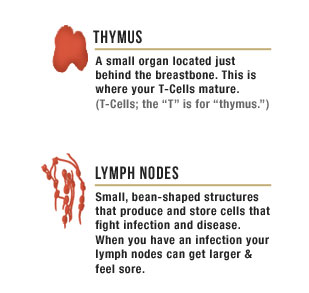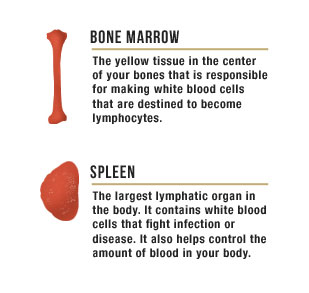How does your immune system work?
Your immune system works because your body is able to recognize "self" and "non-self." This means that your body is able to tell if an invader (virus, bacteria, parasite, or other another person's tissues) has entered it—even if you aren't consciously aware that anything has happened. Your body recognizes this invader and uses a number of different tactics to destroy it.
Major Players of the Immune System

Lymph nodes (also called "lymph glands"): These small, bean-shaped structures are part of your lymphatic system. That system is made up of tissues and organs (bone marrow, spleen, thymus, and lymph nodes) that produce and store cells that fight infection and disease, along with the clear fluid, lymph, that carries those cells to different parts of the body. Lymph nodes filter the lymphatic fluid and store special cells that can trap cancer cells or bacteria that are traveling through your body in the lymph fluid. Lymph nodes are critical for your body's immune response and many of your immune reactions begin there. When you have an infection, your lymph nodes can get larger and feel tender or sore.
Thymus: A small organ located just behind your breastbone. This is where your T-cells mature (That's why they are called T-cells. The "T" is for "thymus.")
Spleen: The largest lymphatic organ in the body—it's about the size of your fist. Your spleen is located in the upper-left part of your abdomen. It contains white blood cells that fight infection or disease. Your spleen also helps control the amount of blood in your body and destroys old and damaged blood cells.
Bone Marrow: The yellow tissue in the center of your bones that is responsible for making white blood cells that are destined to become lymphocytes.
Lymphocytes: A small white blood cell that plays a large role in defending the body against disease. There are two main types of lymphocytes: B-cells and T-cells. B-cells make antibodies that attack bacteria and toxins. T-cells help destroy infected or cancerous cells attack body cells themselves when they have been taken over by viruses or have become cancerous.
The Immune System in Action
Your immune system has many different ways of fighting off foreign invaders. When confronted with a virus, your body responds by activating specific processes of the immune system. First your body recognizes a foreign antigen and delivers it to the lymph system, where it is ingested by a macrophage.
Then the macrophage processes the virus and displays the antigens for that particular virus on its own exterior. This antigen then signals a helper T- cell.
Next the T-cell reads this signal and sounds the alarm for other parts of your immune system to respond.
The B-cell responds to this call and comes to read the antigen from the surface of the macrophage.
The B cell then becomes activated and produces millions of antibodies that are specific to the antigen. These antibodies are released into your body to attach to the virus particles.
These antibodies are important because the invading virus may outnumber your own immune system cells. The antibodies attach to the antigens and hold on tight.
These antibodies then send a signal to other macrophages and other immune cells to come and engulf and destroy the antibody and whatever it has captured.
The final stage of your immune response involves the suppressor T-cell. Once the number of invaders has dropped significantly and the infection has resolved, the suppressor T-cell will signal the other cells of the immune system to rest. This is important as prolonged activation of your immune response could eventually lead to damage to your healthy cells.
How HIV affects this complex process
HIV disrupts this process by directly infecting the helper T-cells. Your initial immune response does get rid of a great deal of HIV, but some of it manages to survive and infect these important cells. Once the infected helper T-cells are activated, they work to create new viruses instead of doing the job they are supposed to do in your immune system. In addition, many helper T-cells are destroyed in the HIV replication process.
For more information, see NCI's The Immune System.
Fact Sheets & Print Materials
- National Institute of Allergy and Infectious Diseases - Understanding The Immune System: How It Works (PDF)
Related Topics on AIDS.gov
Frequently Asked Questions
What is the difference between a T-cell and a CD4 cell?
A CD4 cell is a specific type of T-cell. This is why some clinicians use the term interchangeably.
Do our bodies make antibodies to HIV infection?
Yes. In fact, most HIV tests look for those antibodies to indicate that you have been infected with HIV. But, for very complex biological reasons, human antibodies to HIV are not very effective at neutralizing the virus once you have been infected with it.
Additional Resources
- National Institute of Allergy and Infectious Diseases - HIV/AIDS: Understanding—Biology of HIV
- National Cancer Institute - Understanding Cancer Series: The Immune System (Includes information on HIV/AIDS)
Last revised: 08/22/2011



